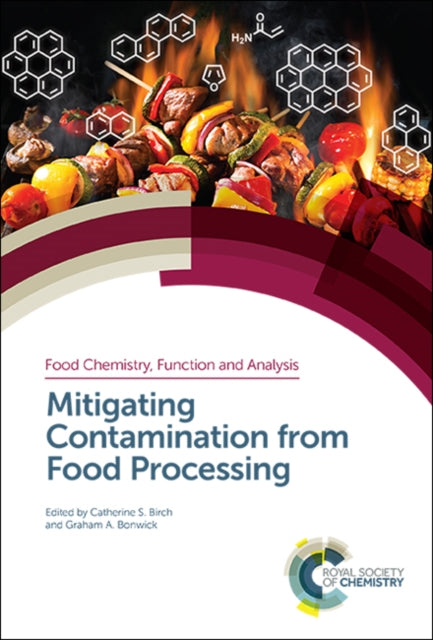Shulph Ink
Mitigating Contamination from Food Processing
Mitigating Contamination from Food Processing
YOU SAVE £7.15
- Condition: Brand new
- UK Delivery times: Usually arrives within 2 - 3 working days
- UK Shipping: Fee starts at £2.39. Subject to product weight & dimension
Bulk ordering. Want 15 or more copies? Get a personalised quote and bigger discounts. Learn more about bulk orders.
Couldn't load pickup availability
- More about Mitigating Contamination from Food Processing
There is a need for efficient methods to identify and measure contaminants in food, especially those that are cheap, simple, and rapid. This book explores the formation of toxic compounds during food processing and offers strategies to mitigate their creation, aiming to update knowledge on current methods for mitigation and provide insights to industrialists, academic researchers, and graduate students.
\n Format: Hardback
\n Length: 225 pages
\n Publication date: 01 November 2019
\n Publisher: Royal Society of Chemistry
\n
Identification and measurement of existing and newly discovered contaminants in the food supply chain are crucial, particularly for those that are cost-effective, straightforward, and rapid. This necessitates more frequent testing to ensure food safety. This book delves into the formation of toxic compounds during food processing and explores strategies to mitigate their creation. By modifying process conditions, the health risks posed by these compounds can be reduced, safeguarding consumers. This comprehensive volume aims to update knowledge on current methods for mitigating process contaminants, serving as a valuable resource for industrialists, academic researchers, and graduate students in the fields of food science and technology, as well as food engineering.
Introduction:
The food supply chain is a complex network of stakeholders involved in the production, distribution, and consumption of food products. It encompasses a wide range of activities, from agricultural production to food processing, packaging, and retail. With the increasing demand for safe and healthy food, the identification and measurement of existing and newly discovered contaminants in the food supply chain have become critical.
Existing Contaminants:
Existing contaminants can arise from various sources, including agricultural practices, food manufacturing processes, and environmental factors. These contaminants can have detrimental effects on human health, such as cancer, reproductive issues, and neurological disorders. Examples of existing contaminants include pesticides, heavy metals, dioxins, and polychlorinated biphenyls (PCBs).
Newly Discovered Contaminants:
In addition to existing contaminants, new contaminants can emerge as a result of technological advancements, changes in agricultural practices, or environmental pollution. These contaminants may not have been detected in the past and can pose significant risks to human health. Examples of newly discovered contaminants include synthetic chemicals, genetically modified organisms (GMOs), and foodborne pathogens.
Identification and Measurement Methods:
Identification and measurement of existing and newly discovered contaminants in the food supply chain require robust and reliable methods. These methods should be cost-effective, simple, and rapid, enabling frequent testing within the food supply chain. Traditional methods of detection, such as chromatography, spectroscopy, and microbiology, are commonly used, but they may be time-consuming and require specialized equipment.
Strategies to Mitigate Contaminant Formation:
To mitigate the formation of contaminants in the food supply chain, several strategies can be implemented. These include improving agricultural practices, implementing Good Agricultural Practices (GAPs), and implementing food safety measures during food processing. Additionally, the use of natural preservatives, organic farming practices, and food packaging materials that are safe and non-toxic can help reduce the risk of contamination.
Conclusion:
The identification and measurement of existing and newly discovered contaminants in the food supply chain are essential for ensuring food safety and protecting public health. Cost-effective, simple, and rapid methods for identification and measurement are required to facilitate more frequent testing within the food supply chain. By implementing strategies to mitigate contaminant formation, we can ensure that the food we consume is safe and healthy.
\n Weight: 514g\n
Dimension: 162 x 240 x 20 (mm)\n
ISBN-13: 9781782629221\n \n
This item can be found in:
UK and International shipping information
UK and International shipping information
UK Delivery and returns information:
- Delivery within 2 - 3 days when ordering in the UK.
- Shipping fee for UK customers from £2.39. Fully tracked shipping service available.
- Returns policy: Return within 30 days of receipt for full refund.
International deliveries:
Shulph Ink now ships to Australia, Belgium, Canada, France, Germany, Ireland, Italy, India, Luxembourg Saudi Arabia, Singapore, Spain, Netherlands, New Zealand, United Arab Emirates, United States of America.
- Delivery times: within 5 - 10 days for international orders.
- Shipping fee: charges vary for overseas orders. Only tracked services are available for most international orders. Some countries have untracked shipping options.
- Customs charges: If ordering to addresses outside the United Kingdom, you may or may not incur additional customs and duties fees during local delivery.


